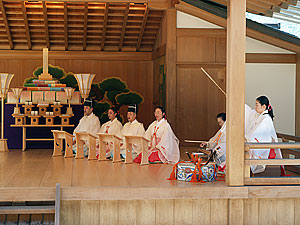
By Bill Roberts
I’m thinking about beans. Not red beans, green beans or lima beans. Not navy beans, pinto beans or prison beans either. And not lentils, black-eyed peas or goober peas (a.k.a. peanuts), which are just beans masquerading as fancy legumes.
No, I’m thinking about soybeans. Not just any old soybeans, the kind some people grow for cattle feed. I’ve been thinking about the prince of beans—Japan’s rich, black soybeans. Did I also say organically grown? That makes them the Crown Prince of Beans.
Organic, black soybeans are to legumes what free-range chicken is to fowl. They are a delicacy used to make the richest soy sauce, the thickest miso soup, and the silkiest tofu. They also make a tasty snack. If you pop one dry-roasted black soybean into your mouth, you can’t stop. They predate Orville Redenbacher popcorn by about 1,000 years.
I’m thinking about black soybeans because I recently spent a half day working with several Oomoto members in an organic black soybean field in bottom land surrounded by hills that turned red, orange and gold before our eyes. It is a lush area west of Kameoka called Tamba. Not the Tamba region known for ceramics, but Tamba, the town, which is known for farm produce. It holds farmers markets four days a week, including one for organic produce. When we stopped there on our way to the field it was not the organic day. We did, however, did see round white turnips as big as volleyballs and white daikon radishes as thick as a sumo wrestler’s leg.
On a crisp Sunday in November, under clouds that threatened rain but only sniffled a bit before lunch, about 20 of us--men, women and children--piled into a small bus and drove an hour to Tamba to work in a field that belongs to Kiichiro Nagasawa. Nagasawa is long-time Oomoto member who sells some of his organic produce at Domo, an organic food store Oomoto owns in Kameoka.
Like California yuppies, snooty Parisians and politically green Germans, affluent Japanese are going organic. It costs more but the results are worth it. Hisae Kishine, an Oomoto member and a chef who does a brisk takeout food business in Tokyo, attributes her success to using the best produce, including organic whenever she can. “It costs a little more, but my customers are willing to pay,” she told me through an interpreter. I met Hisae on a recent trip to Hokkaido.
For Oomoto, organic is part of the spiritual path. Oomoto Co-Founder, Onisaburo Deguchi wrote that creating peace on earth begins with each individual making inner peace. One aspect of inner peace, he wrote, is proper nourishment. Onisaburo died in 1948, long before organic was in vogue. Contemporary Oomoto members interpret his teaching to mean organic food is a spiritual asset in a chemically saturated world.
One day each autumn, members from Kameoka make an excursion to help Nagasawa or another farmer who grows organic produce. This year, we spent two hours clearing leaves and stalks so someone else could come through and pick the beans. Nagasawa’s no fool; he wasn’t about to leave the crown jewels to be picked by rookie field hands on a Sunday lark. We were there for the experience, the camaraderie and whatever spiritual uplift an organic farm might give us.
Organic has become more important to Oomoto in recent years. The Domo store is about five years old. The kitchen staff in Kameoka tries to use organic produce and lists such ingredients when it uses them on its daily menu. About six months ago Oomoto named as chief director Kunihiko Shimamoto, a retired agricultural researcher who developed a system for naturally replenishing enzymes in the soil, a crucial process for successful long-term organic farming. It is unclear what impact his leadership might have on the organic movement here.
Kaname Igarashi, a farmer and Oomoto priest, is familiar with the Shimamoto process. Igarashi raises soybeans, rice, wheat, daikon and other vegetables on his 20 hectare (45.4 acre) farm in Hokkaido. Igarashi, whom I met on my recent trip to Hokkaido, has farmed for 25 years. He recently began to try Shimamoto’s methods. He says the key to successful organic farming is to reduce the need for chemicals by strengthening the crop’s natural resistance to disease and pestilence. Shimamoto’s process helps.
Igarashi hopes eventually to grow as much as 20 percent of his crops organically. He has some doubt about his ability to recover the extra expense of organ farming, so he’s cautious. He has no doubt organic tastes better. “If you bite into a chemically fertilized raw soybean it tastes bitter,” Igarashi tells me through an interpreter. “If you bite into an organic one, it is sweet. You can definitely taste the difference.”
In Nagasawa’s field near Tamba, we did our own taste testing. After working for an hour we broke for tea and a snack—boiled black soybeans in the pod. If you’ve ever been to Georgia maybe you’ve had boiled peanuts, which are tasty little morsels. They don’t match the mildly sweet, richly textured boiled black soybeans Nagasawa served. After two or three you could almost feel a protein rush.
Boiled black soybeans weren’t the only fare Nagasawa fed us. After the tea break, we worked for another hour and then had lunch. It consisted of thick miso soup with tofu and mushrooms cooked on an open fire in the field, and a seasonal delicacy—matsutake rice.
The matsutake (or matsudake) is Japan’s version of Europe’s truffle. Matsutake grow wild in the wooded hills, in moist, dark nooks known only to matsutake hunters, who are territorial about the areas they scour. These mushrooms are rare and very expensive—a few ounces cost several hundred dollars. In a country with little crime, matsutake theft is a problem. Nagasawa happens to be a matsutake wholesaler so he could take as many matsutake as he wanted from his own stockpile and serve them to his guests. Which is what he did. The rice is cooked in soy sauce with flecks of matsutake. Farmhands have never eaten so well.
As much as I like soybeans, I was glad Nagasawa did not serve natto. Natto are fermented soybeans, another staple here. They taste okay and are a good source of protein. The problem is the texture. Thoughts of dog drool or pond scum come to mind, but the polite way to put it is this: The fermentation process leaves a scummy residue that includes long thin sticky threads. Just getting the residue-coated beans from the bowl into your mouth is a challenge. The Japanese swirl and twirl their chopsticks in midair to break the natto strings as they transport the beans to their mouths.
God had a sense of humor when he invented natto. If the organic black soybean is the Crown Prince then natto is surely the Clown Prince of Beans.
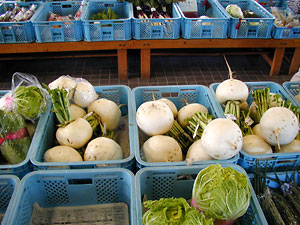 At the farmer's market in Tamba the turnips are as big as volley balls.
At the farmer's market in Tamba the turnips are as big as volley balls.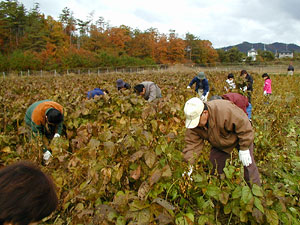 Oomoto members clear the leaves and stalks in Kiichiro Nagasawa's organic black soybean field.
Oomoto members clear the leaves and stalks in Kiichiro Nagasawa's organic black soybean field. 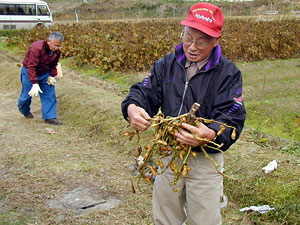 Farmer Kiichiro Nagasawa shows off his pride and joy--black soybeans.
Farmer Kiichiro Nagasawa shows off his pride and joy--black soybeans.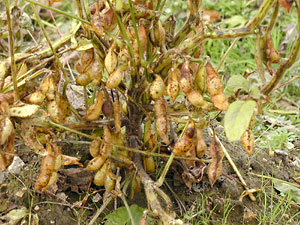 A black soybean plant up close. The beans on the inside are black.
A black soybean plant up close. The beans on the inside are black.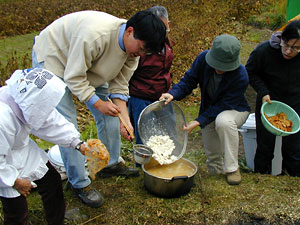 Making miso on an open fire in the field.
Making miso on an open fire in the field.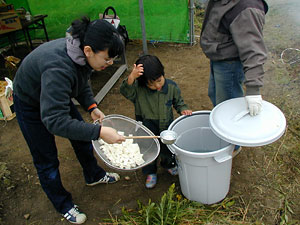 Tofu for the miso soup.
Tofu for the miso soup.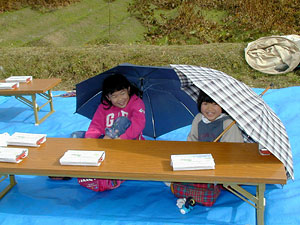 Waiting for lunch.
Waiting for lunch.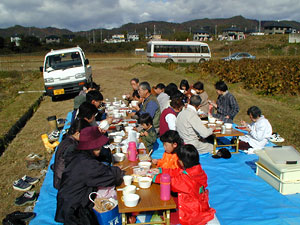 The farmhands enjoyed an outdoor lunch of thick miso soup and matsutake rice.
The farmhands enjoyed an outdoor lunch of thick miso soup and matsutake rice. The Oomoto members who worked in the soybean field and their completed project behind them.
The Oomoto members who worked in the soybean field and their completed project behind them.New Contents Thu, May 20, 2010
- Oomoto participates in Sant’Egidio conference : Dialogue among religions and cultures : On divided island nation of Cyprus By Bill Roberts
- Photo Album : Portraits of three branches: Shoko, Tanegashima and Aomori By Bill Roberts
- Oomoto FAQ
- A Letter from Oomoto : Of mountains and myths By Bill Roberts
- Polyglot poem festival The Utamasturi is going international — what’s next? By Bill Roberts
- Ethics education program captures the spirit of Bankyo Dokon By Bill Roberts
- A Letter from Oomoto : A year’s worth of adventure in a summer of branch visits By Bill Roberts
- In Kumamoto, it’s all about water – and fire By Bill Roberts
- A speech by Nevada Taylor at the Kii Branch in Wakayama Prefecture on April 13, 2008.:An Encounter With Oomoto Through Aikido
- Utamatsuri, Poem Festival, in Tokyo(on April 17, 2008)
- A speech by Neil Ryan Walsh at the Kobe branch on Mar. 9th, 2008.:Planting the Seeds of the Soul
- Meeting with the Fifth Spiritual Leader of Oomoto, Madame Kurenai Deguchi by Neil Ryan Walsh
- A speech by Neil Ryan Walsh at the Nagoya branch on Feb. 17th, 2008.:The Japanese Arts beyond National Boundaries
- To the Oomoto branch in Nagoya: City of Eel and Toyota by Neil Ryan Walsh
- A Speech by Nissim Ben Shitrit, Ambassador of Israel on the occasion of the Oomoto Setsubun Grand Festival in Ayabe February 3rd, 2008 : Japan and Israel : Two Lands Balancing the Needs of Traditional Culture and Modern Life. r
- A permanent memorial to Onisaburo (A Speech at the Autumn Grand Festival , November 6, 2007 : )By James Parks Morton, Founder and Chair, Emeritus of The Interfaith Center of New York
- Israel, Palestine and the Power of Poetry(Oomoto believes small efforts can have lasting ripple effects on people and peace)By Bill Roberts
- “Something Great”(This genetics pioneer, a friend of Oomoto, offers a clue to the mystery of life)By Bill Roberts
- Kamishima Cleanup (Harima branch members regularly visit this sacred island to keep the shrine tidy)By Bill Roberts
- Kyotaro Deguchi was one of six recipients of the 2007 James Parks Morton Interfaith Award
What is Oomoto?
- What is Oomoto?
- Spirtual Centers
- Founders and Spiritual Leaders
- History
- Organization and activities
- Teachings and scriptures
- Art Works of Founders and Leaders
Opinions[Archive]
- Statement of regret for the outbreak of war against Iraq (March 20,2003)
- Jinrui Aizenkai dispatched the "Urgent Appeal for a World (Global) Crisis" on March 14.
Grappling with Bioethics[Archive]
- Oomoto’s support for abolishing the death penalty (12, June 2003)
- The Oomoto Foundation protests any birth of a human clone baby. (5, January 2003)
- OOMOTO'S VIEW REGARDING JAPAN’S PERMITION TO THE RESERCH OF HUMAN EMBRYONIC STEM CELLS (ES cells)(12, June 2000)
Vistor’s Review[Archive]
- A speech by Bill Roberts at the Oomoto branch in Hiroshima after its monthly service on March 18, 2007:Encounters with war and peace
- How Bankyo Dokon changed one life by Linda Macphee
- A speech by Bill Roberts at the Hokuriku (Kanazawa) branch on Dec. 3, 2006:Ritual and myth -an encounter with ‘divine madness’
- A speech by Bill Roberts at the Himeji Cultural Center on Feb. 25, 2007:Mesmerized by the Japanese Arts
- A speech by Bill Roberts at the Kobe branch on Feb. 11th, 2007.:There are just human tears and human joy
- A Speech on the occasion of the Oomoto Setsubun Grand Festival in Ayabe February 3rd, 2007 : Egypt's role in Middle East peace
- Keynote Speech for the 28th World Federation Japanese Religionists Conference for World Peace in Tokyo (at Kokugakuin University, Novermber 29, 2006):Vision for Peace in the Middle East By Dr. Munther S. Dajani, Professor Dean, Faculty of Arts, Al Quds University, Jerusalem
- A speech to the Kyoto branch:Spiritual adventures in researching Oomoto leaders
- A Speech at The Oomoto Foundation on Monday, November 6, 2006 : Jordan's role in Middle East By Samir Nouri, Ambassador of the Hashemite Kingdom of Jordan
- A letter from Oomoto:The Young People of Tottori
- A speech by Bill Roberts on the occasion of the dedication ceremony for the new shrine of Tottori Branch By Bill Roberts Oct. 8, 2006
- A speech by Bill Roberts at the Oomoto branch in Hiroshima after its monthly service on March 18, 2007:Encounters with war and peace
- How Bankyo Dokon changed one life by Linda Macphee
- A speech at Setsubun : A Portrait of Oomoto By Bill Roberts Feb. 3, 2006
- New Publication ! By Bill Roberts Feb. 3, 2006 A Portrait of Oomoto
you can read this book in html => http://www.jinruiaizenkai.jp/English/en-kolumno/en-bill/en-sugao/billbook1en.html
E-mail below to order brobert1@ix.netcom.com
Current Topics
- Prayer Offering and World Religious Forum II
- Living the art of dialogue
- Kyotaro Deguchi was one of six recipients of the 2007 James Parks Morton Interfaith Award
Books
Online Books
- Divine Signposts by Onisaburo DEGUCHI
- The Creation of Meaning by Hidemaru Deguchi
- Bankyo Dokon(Seventy years of Inter-Religious Activity at Oomoto)
- Nao Deguchi — A Biography of the Foundress of Oomoto
- The Great Onisaburo Deguchi published by Aiki News
- Bankyo Dokon Seventy Years of Inter-Religious Activity at Oomoto
- Insearch of Meaning
- Nao Deguchi A Biography of the Foundress of Oomoto
- A Portrait of Oomoto By Bill Roberts
Oomoto international Archive
- The History of Oomoto (Jan.– Mar. 1980 — Apr.– Jun. 1982)
- The Ancestors; Friends or Foes? (Apr.– Jun. 1987)
- Tsukinamisai; The Sabbath of Shinto (Jan.– Jun. 1983)
- The Poem Festival at Oomoto; An Ancient Rite Lives Again (Oct.– Dec. 1981)
- Purification of the Universe ; Oomoto's Setsubun Festival (Apr.– Jun. 1981)
Links
Flowers at Ten'on-kyo & Baisho-en (photographs)
Contact
All rights reserved : the Oomoto Foundation Produced by the Netinformational Commission
Since : Mar. 7.1998 Last Update : Thu, May 20, 2010
E-mail : webmaster@oomoto.or.jp
Top Page Nihongo Esperanto Português Roomazi



